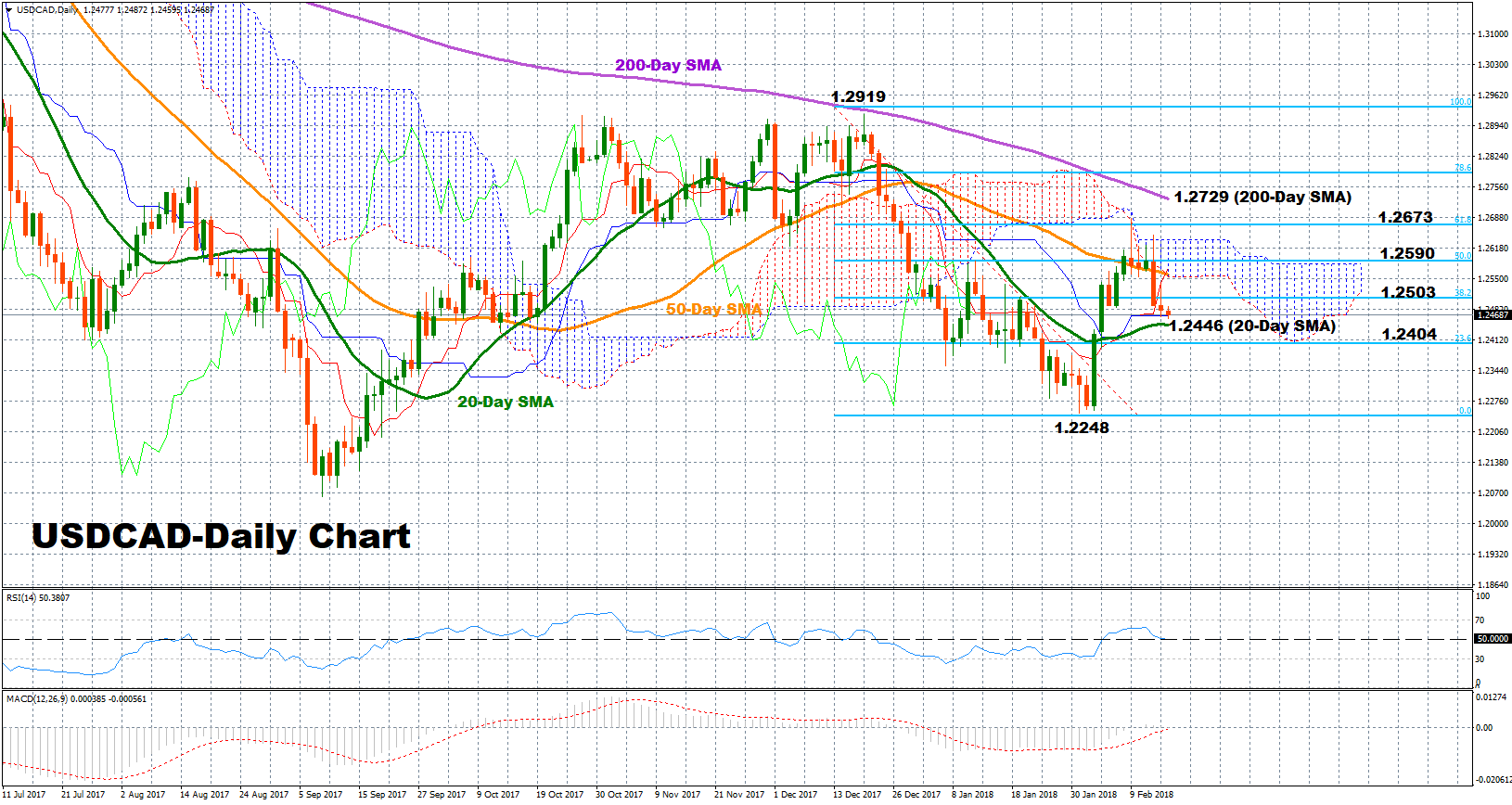USDCAD attempted several times to cross above the 50% Fibonacci of the downleg from 1.2919 to 1.2248 but its efforts were fruitless as it finally reversed direction to test resistance at the 38.2% Fibonacci. The technical indicators now support that the short-term bias is neutral, while in the medium-term the outlook is seen bearish.
The 20-day simple moving average (SMA) has flattened, suggesting that the pair might consolidate for a while. However, if prices manage to fell below this line, a trend reversal to the downside in the near term could be close at hand. The RSI also shows that some consolidation might emerge since the index is currently attached to its neutral threshold of 50. Yet we cannot exclude any upside movements as the red Tenkan-sen line has recently crossed above the blue Kijun-sen line and is positively sloped.
Should the market head up, the 38.2% Fibonacci at 1.2503 could provide nearby resistance before the 50% Fibonacci at 1.2590 of the downleg from 1.2919 to 1.2248 come into view. The latter is seen as a stronger barrier as the area has been approached several times in the past and, while the pair would need to break the 50-day SMA as well. Therefore, a substantial close above this level would resume the recent upswing, opening the way towards the 61.8% Fibonacci of 1.2673. A leg above the 200-day SMA of 1.2729 could also increase bullish sentiment in the long-term.
To the downside, immediate support could come from the 20-day SMA at 1.2446 ahead of the 23.6% Fibonacci at 1.2404. Further below, the focus would shift to the 1.2300 key-level and the previous low of 1.2248.
Regarding the medium-term picture, the outlook is bearish as long as the market keeps trading below the 50-day SMA and the bearish crossover between the 50- and the 200-day SMA remains intact.
Forex trading and trading in other leveraged products involves a significant level of risk and is not suitable for all investors.
Recommended Content
Editors’ Picks
EUR/USD trades with negative bias, holds above 1.0700 as traders await US PCE Price Index

EUR/USD edges lower during the Asian session on Friday and moves away from a two-week high, around the 1.0740 area touched the previous day. Spot prices trade around the 1.0725-1.0720 region and remain at the mercy of the US Dollar price dynamics ahead of the crucial US data.
USD/JPY jumps above 156.00 on BoJ's steady policy

USD/JPY has come under intense buying pressure, surging past 156.00 after the Bank of Japan kept the key rate unchanged but tweaked its policy statement. The BoJ maintained its fiscal year 2024 and 2025 core inflation forecasts, disappointing the Japanese Yen buyers.
Gold price flatlines as traders look to US PCE Price Index for some meaningful impetus

Gold price lacks any firm intraday direction and is influenced by a combination of diverging forces. The weaker US GDP print and a rise in US inflation benefit the metal amid subdued USD demand. Hawkish Fed expectations cap the upside as traders await the release of the US PCE Price Index.
Sei Price Prediction: SEI is in the zone of interest after a 10% leap

Sei price has been in recovery mode for almost ten days now, following a fall of almost 65% beginning in mid-March. While the SEI bulls continue to show strength, the uptrend could prove premature as massive bearish sentiment hovers above the altcoin’s price.
US core PCE inflation set to signal firm price pressures as markets delay Federal Reserve rate cut bets

The core PCE Price Index, which excludes volatile food and energy prices, is seen as the more influential measure of inflation in terms of Fed positioning. The index is forecast to rise 0.3% on a monthly basis in March, matching February’s increase.
